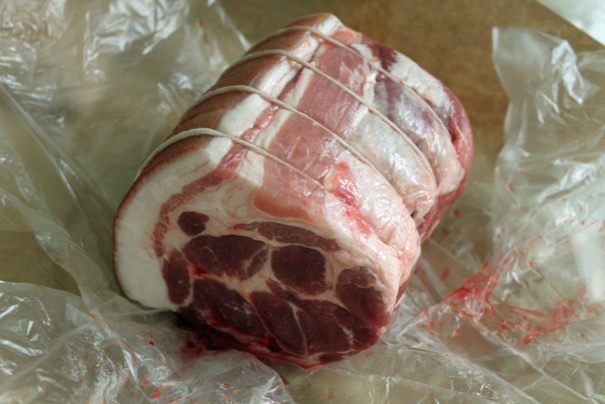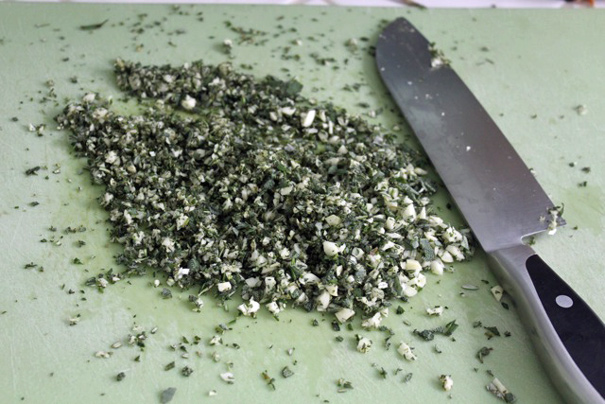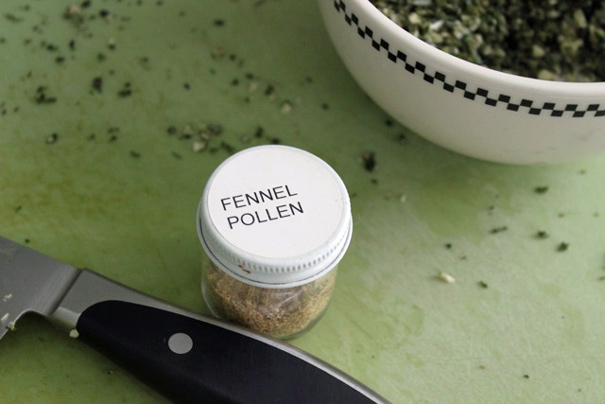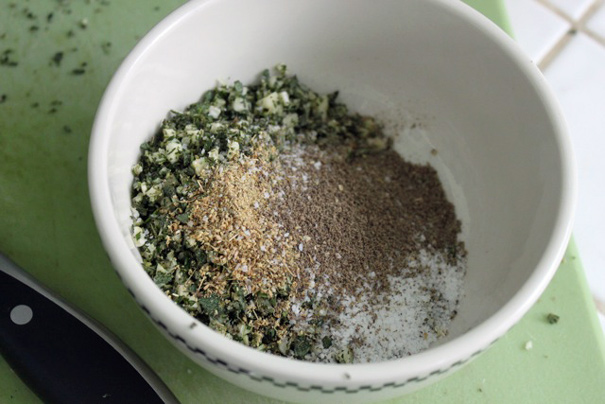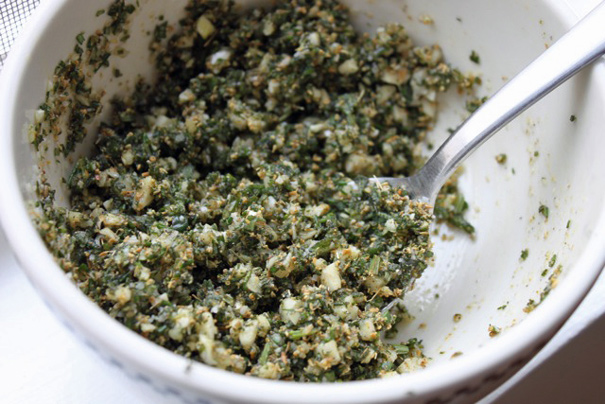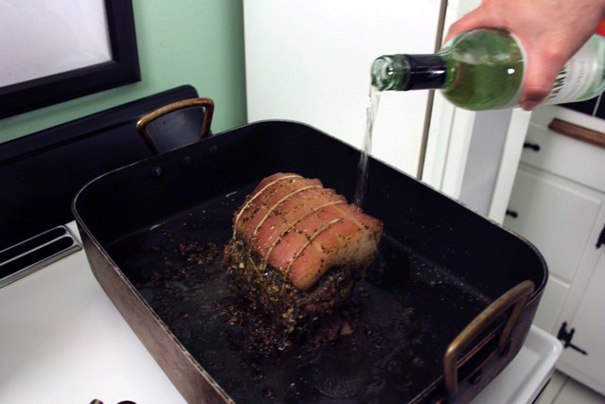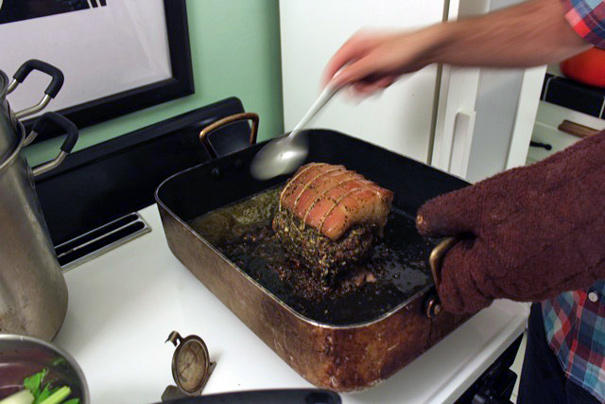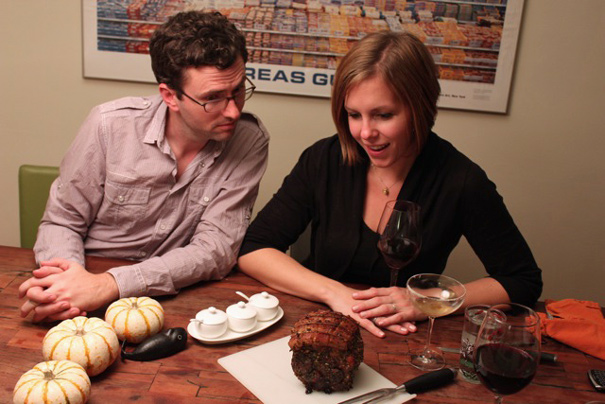Porchetta At Home
We're all aware of Porchetta the destination, aren't we? Located on East 7th Street in New York's East Village, Chef Sara Jenkins (who I met and interviewed a few months ago) has created a universally beloved destination for pork lovers. The menu there features two main choices: porchetta on a sandwich or porchetta on a plate. The experience of eating the Porchetta porchetta--which the Porchetta website defines as "roasted pork with crispy skin, highly seasoned with aromatic herbs and spices, garlic, sage, rosemary and wild fennel pollen"--is so sublime, so otherworldly, I knew I had to recreate the experience here in my Los Angeles apartment.
I e-mailed Chef Jenkins to ask for her advice about making porchetta at home. She pointed out that the Porchetta website has the porchetta recipe. Well: that made things easy! That's the recipe I used last Thursday when I tackled my very first porchetta.
Actually, the process started the day before. I called my favorite L.A. butchers--Lindy & Grundy--and told them that I needed a pork shoulder with the skin still attached. "No problem," said the voice on the other end. And when I went to pick it up a few hours later, Amelia (one half of the Lindy & Grundy empire) posed for this picture:
Now I don't know if you can see how beautiful that cut of meat is, but let's look closer, shall we?
That's a beautifully butchered piece of meat. And the truth is, once you have that, you really can't screw up your porchetta. You simple make a potent herb mixture using rosemary, thyme, sage, garlic and fennel pollen:
After that, you simply make slits all over the pork--ten slits in all--and shove 1/3rd of that mixture in with your fingers (or a spoon). Rub the remaining mixture all over the pork:
And place it, fat side up, in a 250 degree oven for two hours. After that, you pour 1/2 a cup of white wine on top (I think I added more like one cup) and baste the pork with the wine and juices:
Back in the oven it goes, and you continue roasting for 2 1/2 to 3 hours more, basting every hour, until the internal temperature is between 170 and 180 degrees F. (The website says the meat should be "spoon tender" and I have to confess, that didn't happen for me; but the meat itself, once sliced was incredibly moist and tender. Just not spoon tender.) Chef Jenkins suggested that I take the meat out of the oven, pump up the oven temp to 500 (or 550 if possible) and to place it back in just for a few minutes to crisp the skin. I followed her advice, which is why the porchetta had such an impressive exterior when I presented it to Craig and our friend Emily:
Sliced up, this porchetta was a rock star:
The fat on top kept the meat ultra-moist and then all of those aromatics make for a most potent flavor. (In fact, I Tweeted as I roasted it that my apartment never smelled better; it's a pretty magical smell that smell of pork, rosemary, thyme, sage and garlic cooking together.) I served it up on polenta (enhanced with mascarpone and Parmesan), though cooked greens (like broccoli rabe sauteed with garlic) might've enhanced the plate even more.
That said, when you have porchetta on your plate, nothing else really matters. So thanks to Chef Jenkins for her advice and for being so generous with her recipe. Now that I can make porchetta here in L.A., I'll miss New York just a tiny bit less.
Recipe: Porchetta
Summary: Sara Jenkins' signature recipe from Porchetta in New York's East Village.
Ingredients
- 1 (3 3/4 to 4 pound) boneless pork shoulder (skin on, not tied)
- 20 fresh sage leaves
- 3 leafy sprigs fresh thyme, leaves removed
- 3 leafy sprigs rosemary, stemmed
- 2 garlic cloves, peeled and roughly chopped (I used more--like 3 to 4)
- 2 tablespoons fennel pollen
- 1 1/2 teaspoons medium coarse sea salt (I used more than this too; more like a tablespoon or two)
- 1 1/2 teaspoons freshly cracked black pepper
- 2 tablespoons extra-virgin olive oil
- 1/2 cup dry red or white wine
Instructions
- Heat oven to 250 degrees F.
- Use a sharp knife to score the pork skin in a cross-hatch diamond pattern (I had my butcher do this, so I didn't have to. Thanks Lindy & Grundy!)
- Finely chop the sage, thyme, rosemary and garlic and stir it together with the fennel pollen, salt, and pepper.
- With a paring knife, making 10 incisions (about 1/2-inch deep) all over the pork and stuff those slits with 1/3rd of the herb mixture. Tie the pork (I had my butcher do this too), brush oil all over the skin and rub the pork with the remaining herb mixture.
- Set the pork in a roasting pan, fat side up, and roast for two hours. Pour the wine over the pork and baste with the wine and pork juices. Continue roasting, basting once every hour, until the skin is well browned and the meat is spoon tender 2 1/2 to 3 hours more (the internal temperature should be between 170 and 180). Remove from the oven, turn the oven temp up to 500 degrees and return the pan to the oven just for a minute or two until the skin is extra crisp. Remove again and let the meat rest for 15 minutes before slicing and serving.
Preparation time: 20 minute(s)
Cooking time: 5 hour(s)
Number of servings (yield): 6
Culinary tradition: Italian
My rating



